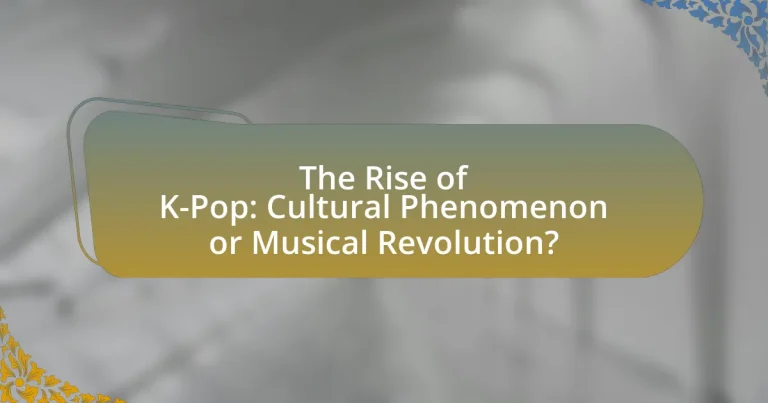The article examines the rise of K-Pop, a genre of South Korean pop music that has gained significant global popularity since the late 1990s. It explores the historical factors contributing to K-Pop’s emergence as a cultural phenomenon, including government support, technological advancements, and strategic marketing. Key components of K-Pop’s success, such as high production values, rigorous training systems for artists, and the role of social media and streaming platforms, are analyzed. The article also addresses the challenges K-Pop faces, including market saturation and cultural appropriation, while highlighting the genre’s influence on global music trends and its reflection of South Korean culture and identity.

What is the Rise of K-Pop?
The rise of K-Pop refers to the significant global popularity and influence of South Korean pop music, characterized by its catchy melodies, high-energy performances, and visually appealing music videos. This phenomenon began in the late 1990s with groups like H.O.T. and gained momentum in the 2010s, particularly with the international success of bands such as BTS and BLACKPINK. By 2020, BTS became the first South Korean act to top the Billboard Hot 100 chart, showcasing K-Pop’s mainstream appeal. The genre’s rise is supported by strategic use of social media platforms, which have facilitated global fan engagement and contributed to its cultural impact.
How did K-Pop emerge as a global phenomenon?
K-Pop emerged as a global phenomenon through a combination of strategic marketing, innovative music production, and the rise of social media platforms. The South Korean government actively supported the Hallyu Wave, promoting Korean culture internationally, which included K-Pop. The genre’s catchy melodies, high-quality production, and visually appealing music videos attracted a diverse audience. Additionally, groups like BTS and BLACKPINK gained massive followings, breaking records on platforms like YouTube and Spotify, with BTS becoming the first K-Pop act to top the Billboard Hot 100 chart in 2020. This global reach was further amplified by dedicated fan engagement through social media, allowing fans worldwide to connect and promote their favorite artists.
What historical factors contributed to the rise of K-Pop?
The rise of K-Pop can be attributed to several historical factors, including the globalization of media, government support for cultural exports, and the influence of Western music trends. In the late 1990s, South Korea’s government initiated the “Cultural Industry Promotion Act,” which aimed to boost the country’s cultural exports, leading to increased investment in the music industry. Additionally, the advent of the internet and social media platforms in the 2000s allowed K-Pop to reach a global audience, facilitating fan engagement and international collaborations. The blending of diverse musical styles, particularly from Western pop, hip-hop, and R&B, further enhanced K-Pop’s appeal, making it a unique genre that resonates with a wide range of listeners.
How did technology influence the spread of K-Pop?
Technology significantly influenced the spread of K-Pop by enabling global access to music and content through digital platforms. The rise of social media platforms like YouTube allowed K-Pop artists to reach international audiences directly, bypassing traditional media barriers. For instance, the music video for PSY’s “Gangnam Style” went viral on YouTube, accumulating over 4 billion views, which exemplifies how digital platforms can propel a song to global fame. Additionally, streaming services like Spotify and Apple Music have made K-Pop more accessible, contributing to its international popularity. The use of mobile apps and social media for fan engagement has also fostered a dedicated global fanbase, further amplifying the genre’s reach.
Why is K-Pop considered a cultural phenomenon?
K-Pop is considered a cultural phenomenon due to its global influence and the way it transcends cultural boundaries. The genre has gained immense popularity worldwide, with groups like BTS and BLACKPINK achieving record-breaking sales and social media engagement, exemplified by BTS’s “Dynamite” becoming the first song by a South Korean act to top the Billboard Hot 100 chart in 2020. This widespread appeal is further evidenced by K-Pop’s integration into various cultures, as seen in international collaborations and the incorporation of diverse musical styles, which attract a broad audience. Additionally, K-Pop’s unique blend of music, fashion, and choreography creates a distinct cultural identity that resonates with fans globally, solidifying its status as a cultural phenomenon.
What cultural elements are prominent in K-Pop?
Prominent cultural elements in K-Pop include a blend of traditional Korean aesthetics, global musical influences, and a strong emphasis on visual presentation. Traditional elements are often reflected in the use of hanbok-inspired fashion, Korean folklore themes in music videos, and incorporation of Korean language and cultural references in lyrics. Global influences manifest through diverse musical styles such as hip-hop, R&B, and electronic dance music, appealing to a wide international audience. The visual aspect is highlighted by elaborate choreography, high production values, and striking fashion, which are integral to K-Pop performances. These elements collectively contribute to K-Pop’s unique identity and its global appeal, evidenced by the genre’s significant international chart success and fan engagement across various platforms.
How does K-Pop reflect South Korean culture and identity?
K-Pop reflects South Korean culture and identity through its integration of traditional values, modern aesthetics, and global influences. The genre often incorporates themes of community, family, and respect, which are central to South Korean society, while also embracing contemporary fashion, technology, and diverse musical styles. For instance, K-Pop groups frequently showcase elaborate choreography and visually stunning music videos that highlight both cultural heritage and modernity, exemplified by the use of traditional Korean instruments alongside Western pop elements. This blend not only appeals to domestic audiences but also resonates globally, illustrating South Korea’s cultural export and soft power. The success of groups like BTS and BLACKPINK demonstrates how K-Pop serves as a vehicle for expressing national pride and cultural identity on an international stage, contributing to the Hallyu wave that has significantly increased interest in South Korean culture worldwide.
In what ways is K-Pop a musical revolution?
K-Pop is a musical revolution due to its innovative blend of genres, high production values, and global reach. The genre incorporates elements from pop, hip-hop, R&B, and electronic music, creating a unique sound that appeals to diverse audiences. K-Pop’s production quality is often characterized by elaborate choreography, visually stunning music videos, and intricate stage performances, setting new standards in the music industry. Additionally, K-Pop has achieved unprecedented global success, with groups like BTS and BLACKPINK breaking records on international charts and amassing millions of followers worldwide, demonstrating its influence beyond South Korea. This global phenomenon is further evidenced by BTS becoming the first K-Pop act to top the Billboard Hot 100 chart in 2020, showcasing K-Pop’s significant impact on the global music landscape.
What are the unique musical characteristics of K-Pop?
K-Pop is characterized by its diverse musical styles, blending elements from genres such as pop, hip-hop, R&B, electronic dance music, and rock. This genre often features catchy melodies, intricate choreography, and high production values, which contribute to its global appeal. Additionally, K-Pop songs frequently incorporate multiple languages, including Korean and English, enhancing accessibility for international audiences. The use of visual storytelling in music videos and performances further distinguishes K-Pop, creating a multi-sensory experience that captivates fans.
How does K-Pop differ from traditional pop music genres?
K-Pop differs from traditional pop music genres primarily through its integration of diverse musical styles, elaborate choreography, and a strong emphasis on visual aesthetics. Unlike traditional pop, which often focuses on vocal performance and songwriting, K-Pop incorporates elements from hip-hop, R&B, electronic dance music, and rock, creating a hybrid sound that appeals to a global audience. Additionally, K-Pop artists undergo rigorous training in dance and performance, resulting in highly synchronized and visually captivating performances. The genre also places significant importance on visual presentation, including fashion and music videos, which are often produced with high production values. This multifaceted approach has contributed to K-Pop’s rapid rise in popularity worldwide, evidenced by the global success of groups like BTS and BLACKPINK, who have broken records on international music charts and amassed millions of followers across social media platforms.
What role do social media and streaming platforms play in K-Pop’s rise?
Social media and streaming platforms are crucial in K-Pop’s rise, as they facilitate global accessibility and fan engagement. Platforms like YouTube allow K-Pop music videos to reach millions of viewers worldwide, contributing to the genre’s international popularity; for instance, BTS’s “Dynamite” amassed over 100 million views within 24 hours of its release in 2020. Additionally, social media platforms such as Twitter and Instagram enable artists to connect directly with fans, fostering a dedicated global community that amplifies their reach and influence. This direct interaction has been shown to enhance fan loyalty and drive streaming numbers, further solidifying K-Pop’s position in the global music market.
How have platforms like YouTube changed the way K-Pop is consumed?
Platforms like YouTube have revolutionized K-Pop consumption by providing global accessibility and instant engagement. The platform allows fans worldwide to watch music videos, live performances, and behind-the-scenes content, breaking geographical barriers that previously limited exposure. For instance, in 2020, BTS’s “Dynamite” music video garnered over 100 million views within 24 hours of its release, showcasing the immense reach and impact of YouTube on K-Pop’s popularity. Additionally, YouTube’s algorithm promotes content based on user preferences, enabling fans to discover new artists and songs easily, further fueling the genre’s growth.
What impact does social media have on K-Pop fandoms?
Social media significantly enhances K-Pop fandoms by facilitating global connectivity and engagement among fans. Platforms like Twitter, Instagram, and TikTok allow fans to share content, organize events, and communicate in real-time, fostering a sense of community. For instance, the #BTSArmy hashtag has mobilized millions of fans worldwide, demonstrating the power of social media in uniting diverse groups around a common interest. Additionally, social media serves as a primary channel for artists to interact with their fans, providing updates and behind-the-scenes content, which strengthens fan loyalty and investment in the artists’ careers. This dynamic has been crucial in the international success of K-Pop, as evidenced by the rapid growth of fanbases and the ability to trend globally on social media platforms.
What are the key components of K-Pop’s success?
The key components of K-Pop’s success include a combination of high-quality production, rigorous training systems for artists, strategic marketing, and a strong fan culture. High-quality production is evident in the genre’s polished music videos and catchy songs, which often incorporate diverse musical styles. The rigorous training systems, where idols undergo years of preparation in singing, dancing, and public relations, ensure that performers are highly skilled and marketable. Strategic marketing, including the use of social media and global collaborations, has expanded K-Pop’s reach beyond South Korea. Additionally, a strong fan culture, characterized by dedicated fan clubs and interactive engagement, fosters loyalty and amplifies the genre’s popularity. These components collectively contribute to K-Pop’s status as a global phenomenon.
How do training systems for K-Pop idols contribute to their success?
Training systems for K-Pop idols significantly contribute to their success by providing rigorous and comprehensive training in various disciplines such as singing, dancing, and performance skills. These systems often span several years, during which trainees undergo intense practice and evaluation, ensuring they meet high industry standards. For instance, companies like SM Entertainment and YG Entertainment invest heavily in training programs that include vocal coaching, choreography, and media training, which prepare idols for the competitive nature of the K-Pop industry. The structured environment fosters discipline and resilience, essential traits for navigating the pressures of fame. Additionally, the training often includes exposure to diverse musical styles and performance techniques, enhancing the idols’ versatility and appeal to a global audience. This systematic approach has been validated by the success of groups like BTS and BLACKPINK, who have achieved international acclaim, demonstrating the effectiveness of these training systems in shaping successful K-Pop artists.
What marketing strategies are employed by K-Pop agencies?
K-Pop agencies employ a variety of marketing strategies to promote their artists and maximize their reach. These strategies include social media engagement, targeted advertising, and the use of visually appealing content such as music videos and performance showcases. For instance, agencies like SM Entertainment and YG Entertainment leverage platforms like YouTube and Instagram to create viral content, which significantly boosts visibility and fan interaction. Additionally, K-Pop agencies often utilize fan events, merchandise sales, and collaborations with global brands to enhance their marketing efforts, as evidenced by BTS’s partnership with McDonald’s, which generated substantial media coverage and fan engagement.
How does K-Pop influence global music trends?
K-Pop significantly influences global music trends by introducing innovative production techniques, diverse musical styles, and a strong visual aesthetic. This genre has popularized elements such as catchy hooks, choreographed dance routines, and high-quality music videos, which have been adopted by artists worldwide. For instance, the success of BTS and BLACKPINK has led to increased collaborations between Western and K-Pop artists, showcasing a blending of genres and styles. Additionally, the global reach of K-Pop is evidenced by its presence on platforms like Billboard, where K-Pop songs frequently chart, indicating its impact on mainstream music consumption and trends.
What collaborations have K-Pop artists engaged in with Western musicians?
K-Pop artists have engaged in numerous collaborations with Western musicians, significantly enhancing their global presence. Notable examples include BTS collaborating with Halsey on “Boy With Luv,” which topped charts worldwide, and BLACKPINK teaming up with Dua Lipa for “Kiss and Make Up,” showcasing their crossover appeal. Additionally, the collaboration between PSY and Snoop Dogg on “Hangover” further exemplifies the blending of K-Pop with Western music. These partnerships have not only resulted in chart-topping hits but have also contributed to the cultural exchange between the two music industries.
How has K-Pop shaped the music industry outside of South Korea?
K-Pop has significantly shaped the music industry outside of South Korea by influencing global music trends, expanding the reach of non-English music, and altering marketing strategies. The genre’s catchy melodies, high production values, and visually appealing performances have led to increased interest in Asian pop culture, resulting in collaborations between K-Pop artists and Western musicians, such as BTS working with Halsey and Lil Nas X. Furthermore, the global success of K-Pop groups has prompted record labels worldwide to invest in diverse talent and adopt similar training and promotional techniques, as evidenced by the rise of international K-Pop-inspired acts. This phenomenon has also contributed to the growth of streaming platforms, with K-Pop dominating charts in various countries, showcasing its impact on music consumption patterns.
What challenges does K-Pop face in maintaining its popularity?
K-Pop faces several challenges in maintaining its popularity, including market saturation, changing consumer preferences, and intense competition. Market saturation occurs as numerous groups debut each year, making it difficult for any single act to stand out. Changing consumer preferences, particularly among younger audiences who may shift their interests towards different genres or platforms, also pose a threat. Additionally, intense competition from both domestic and international music markets, such as Western pop and other Asian music genres, further complicates K-Pop’s ability to retain its audience. These factors collectively contribute to the ongoing struggle for K-Pop to sustain its global appeal.
How do cultural appropriation and criticism affect K-Pop’s image?
Cultural appropriation and criticism significantly impact K-Pop’s image by generating both backlash and increased awareness of cultural sensitivity. Incidents where K-Pop artists have been accused of appropriating elements from various cultures, such as traditional clothing or music styles, often lead to public outcry and discussions about respect and representation. For instance, the controversy surrounding certain music videos that feature cultural symbols without proper context has sparked debates on social media, influencing public perception and potentially alienating fans. This criticism can lead to a tarnished reputation for the artists involved and the industry as a whole, prompting K-Pop companies to adopt more culturally aware practices. As a result, K-Pop’s image is shaped by the balance between its global appeal and the need for cultural respect, highlighting the complexities of navigating diverse cultural landscapes in a globalized music industry.
What are the potential impacts of oversaturation in the K-Pop market?
Oversaturation in the K-Pop market can lead to decreased consumer interest and financial instability for entertainment companies. As the number of groups and releases increases, fans may feel overwhelmed, resulting in diminished engagement and loyalty. For instance, a report by the Korea Creative Content Agency indicated that the rapid influx of new groups in 2020 led to a decline in album sales for established artists, highlighting the competitive strain on the market. Additionally, oversaturation can dilute the quality of music and performances, as companies may prioritize quantity over artistic development, potentially harming the overall reputation of the genre.
What can fans do to support K-Pop artists effectively?
Fans can effectively support K-Pop artists by purchasing their music, merchandise, and concert tickets. This financial support directly contributes to the artists’ revenue and success. For instance, the global sales of K-Pop albums reached over 10 million copies in 2020, demonstrating the significant impact of fan purchases on artists’ careers. Additionally, engaging with artists on social media platforms, streaming their music on legal platforms, and participating in fan events further amplify their visibility and popularity. These actions not only enhance the artists’ market presence but also foster a strong community among fans, which is crucial for the sustained growth of K-Pop as a cultural phenomenon.
How can fans engage with K-Pop in a meaningful way?
Fans can engage with K-Pop in a meaningful way by participating in fan communities and supporting artists through various platforms. Engaging in online forums, social media groups, and fan clubs allows fans to share their experiences, discuss music, and connect with others who share similar interests. Additionally, purchasing albums, attending concerts, and streaming music on legal platforms directly supports the artists financially, contributing to their success. Research indicates that active fan participation can enhance the overall K-Pop experience, fostering a sense of belonging and community among fans.
What are the best practices for supporting K-Pop music and culture?
To support K-Pop music and culture effectively, fans should actively engage in purchasing official merchandise, streaming music on licensed platforms, and attending concerts. Purchasing official merchandise contributes to the financial success of artists and labels, while streaming on platforms like Spotify or Apple Music ensures that artists receive royalties, which is crucial for their sustainability. Attending concerts not only provides direct support but also fosters a sense of community among fans. According to a report by the Korea Creative Content Agency, the K-Pop industry generated approximately $5 billion in revenue in 2020, highlighting the economic impact of fan support.


